theartsdesk Q&A: Lighting Designer Michael Hulls | reviews, news & interviews
theartsdesk Q&A: Lighting Designer Michael Hulls
theartsdesk Q&A: Lighting Designer Michael Hulls
Olivier Award-winning genius with light and dance explains his art
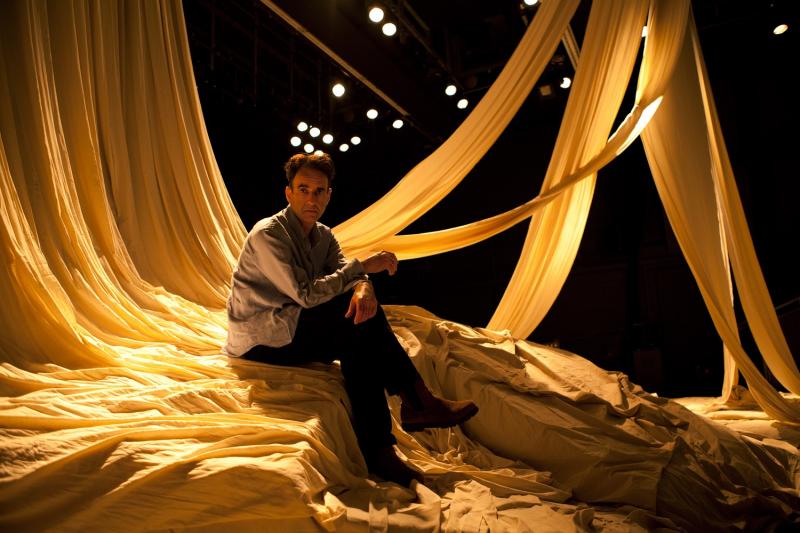
Last night the Olivier Awards handed their top honour for dance not to a dancer but to the man who shines the lights on the dancers. Michael Hulls, winner of the Outstanding Achievement in Dance award, paints the dancing of Sylvie Guillem, Akram Khan, Russell Maliphant and the Ballet Boyz with atmospheres and illuminations that seem to reach beyond the visual and into some paranormal place.
Lighting designers are either wizards or useful pedants. They scrupulously light the action or they make light speak its own language, activating space, time, illusion, imagination - inventing effects that your blinking eyes can only consider as magic. No one performs this wizardry more outstandingly than Hulls, who has become a co-creator in a new form of dance-theatre, where light and movement are an inseparable duet.
He and Maliphant invented this collaborative idea tentatively 20 years ago, and their unbroken partnership ever since has led from obscure early solos to the international acclaim brought by their creations with Guillem and the Ballet Boyz, the astounding trio at the Royal Opera House Broken Fall, and Akram Khan's astonishingly beautiful DESH. Only just this last week Hulls, while admitting on Twitter he had not had enough time to do something spectacularly original, contributed the aching between-worlds atmosphere of the new Maliphant work for English National Ballet in their World War 1 new-choreography programme, Second Breath.
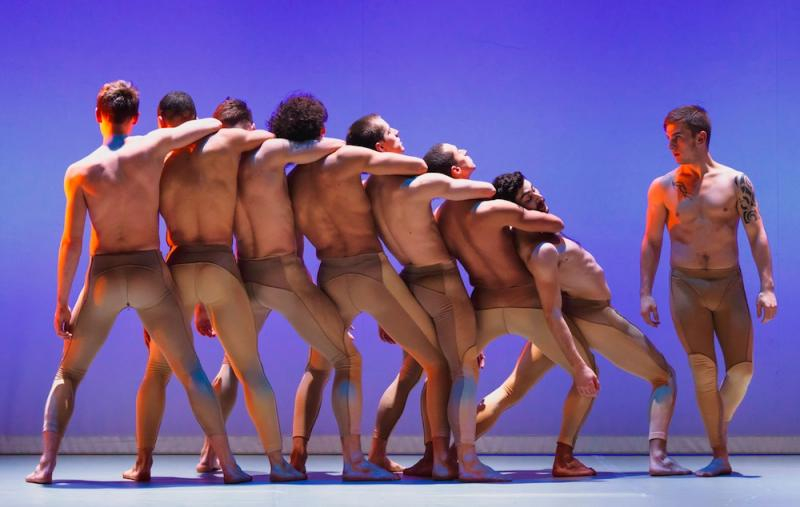 Hulls' list of achievements is a catalogue of many of my most unforgettable experiences of watching dance for the past 20 years. It was he who bathed Guillem and Maliphant in auras and glows in their duet, Push, and in their picturesque orientalist work with Robert Lepage, Eonnagata. It was Hulls who brought out with his lights, in Maliphant’s duets for the Ballet Boyz, a powerful undertow of both male rivalry and unbreakable friendship. A recent production cited by the Oliviers last night was his work with the Ballet Boyz's latest double bill by Liam Scarlett and Maliphant (Scarlett's Serpent pictured right by Panayiotis Sinnos).
Hulls' list of achievements is a catalogue of many of my most unforgettable experiences of watching dance for the past 20 years. It was he who bathed Guillem and Maliphant in auras and glows in their duet, Push, and in their picturesque orientalist work with Robert Lepage, Eonnagata. It was Hulls who brought out with his lights, in Maliphant’s duets for the Ballet Boyz, a powerful undertow of both male rivalry and unbreakable friendship. A recent production cited by the Oliviers last night was his work with the Ballet Boyz's latest double bill by Liam Scarlett and Maliphant (Scarlett's Serpent pictured right by Panayiotis Sinnos).
And Hulls must bear some of the public outrage ignited by Javier de Frutos's scabrously funny Eternal Damnation to Sancho and Sanchez, with its gross, marauding pope blowing up like a rocket. The lighting designer - once just the man who switched on the stage lights - has come into his own as a creator of theatre's mysteries, games and inner songs.
It seems apt that Hulls (born in 1959) bears a fine sword as one of the few Knights of Illumination. This is an accolade bestowed by the lighting industry on their greats, for his hallucinatory lighting on Eonnagata in 2009. The sword symbolises romance, power, enlightenment and life force. (Compared with the pallid efforts by some of the more workaday lighting designers around, Hulls’ lighting is truly a life force for dance - I’ve never ceased to be amazed by it.)
His journey to the pinnacle is highly unorthodox, as I found when we met two years ago to discuss his preparations at Sadler’s Wells for Maliphant's The Rodin Project. Hulls has no formal training in lighting design. He spilled out over the table sheets of drawings either incredibly neat or wildly scribbled, one being the essential translation for digital programmes to put those dapples, scribbles and mysteries into action on stage. It was not, he told me, a glamorous life, it never has been, since he first went touring with Maliphant, the two of them with a wild idea in their head that light and dance should work in an unprecedently close embrace.
My eyesight is more comfortable at low light levels. I think low levels of light increase the use of all senses
MICHAEL HULLS: For 10 years we just went out on the road, Russell and me, with a CD player, a bag of colours for the lights, a lighting plot, Russell’s costumes, and maybe another dancer. When you get to a theatre there’s a lighting computer, and each light has a number next to it. So you make the plot of the channels, at 1-10, 27 percent, and they’ll come on in 13 seconds, and you input all the information into the machine, then press the button - and things happen as you input it. That’s at the basic level. Lots of people now tour their own lighting computer, so you don’t have to start from scratch in different theatres.
ISMENE BROWN: That’s two sides of the brain, isn’t it? You use one side of the brain to paint the lighting design, then you have to become some kind of pernickety mathematical genius to put it all in place wherever you go.
You don’t have to be a mathematical genius. Now I do things that are beyond my skill in that department, particularly if it’s using modern automated lights that have so many controllable variables. Then the programming actually needs a programmer whom you explain it all to. Some lighting designers are perfectly competent programmers. I’m not like that. I just like to go from A to Z without all the fiddly stuff in the middle, which bores me.
How has lighting changed since Diaghilev’s time? So much lighting now seems to be about hi-tech - what were the lighting people doing a century ago?
There weren’t lighting people. It was just general illumination, with candlelight or electricity. The stage manager was responsible for that.
And always a spotlight on the star!
Yes. And you always had the mix of yellow, pink and blue. And the choreographer would tell the stage manager which colour to switch on. But at the turn of the 20th century, Edward Gordon Craig and Adolphe Appia wanted to create what they described as “form-revealing light”, and that, I guess, was the start of lighting design as a visual medium in itself.
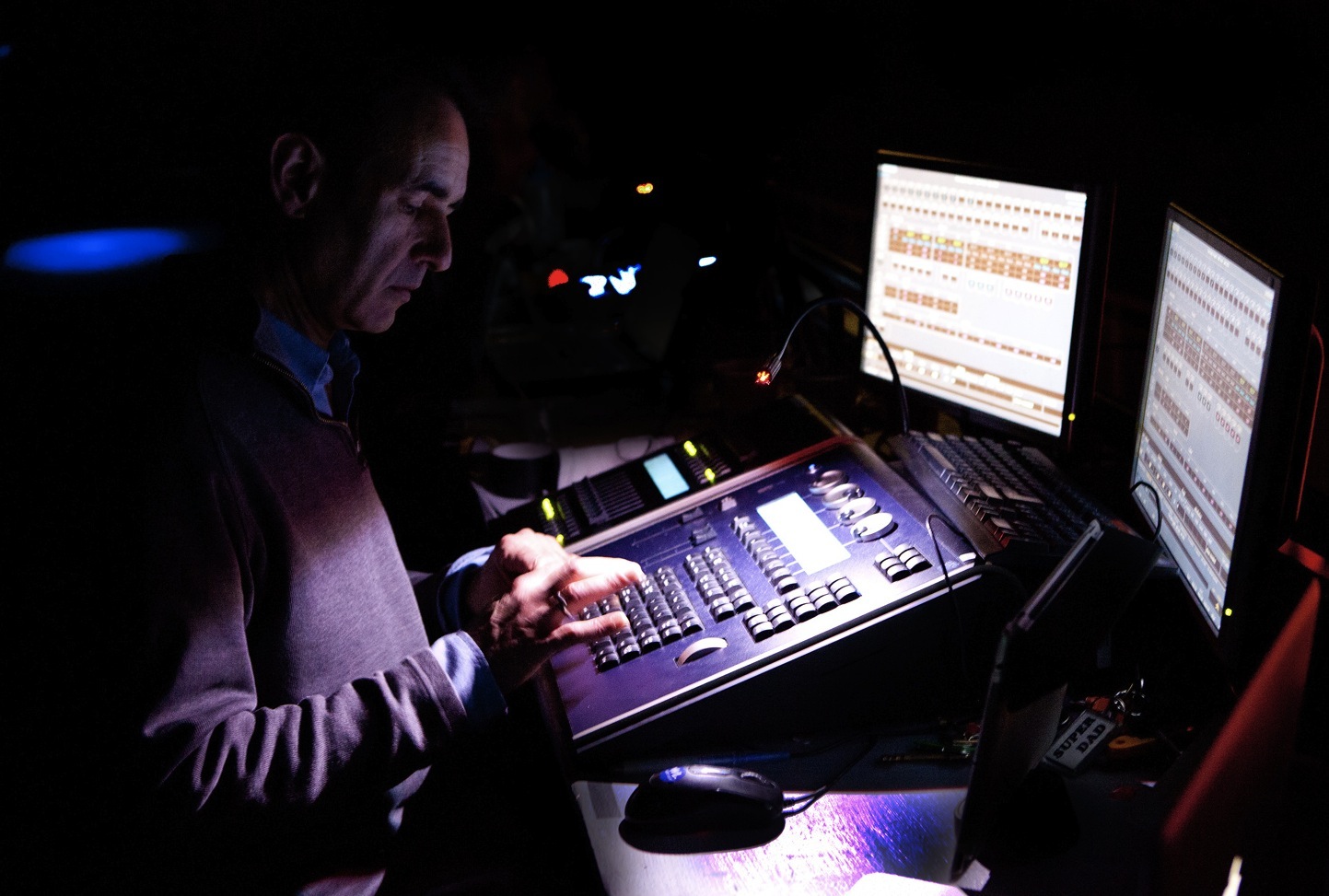 Above: Hulls at work in the Sadler's Wells wings, photographed by Charlotte MacMillan
Above: Hulls at work in the Sadler's Wells wings, photographed by Charlotte MacMillan
I imagine that was why sets were so bright then, because they were the illumination, thinking of the very bright Natalia Goncharova or Léon Bakst sets for instance. Was it wartime austerity perhaps that made lighting more important and sets less so, because it was cheaper?
I don’t know that was the case, but people did begin slowly to develop the art of lighting design in theatre and plays, and develop theories about it.
Movies had some very creative lighting going on in the black and white era, didn’t they? Did that influence theatre lighting technique?
But they were dealing with film and camera, which is very different, because you have a means of controlling what the viewer sees. You’re exposing the film specifically to capture light and dark. But in terms of lighting for dance, I guess it really started with Jean Rosenthal and Martha Graham. And then Jennifer Tipton, whom I think Jean taught, to some extent. That’s the start of the recognition of lighting design in itself, and then later on it caught on in this country when it was exposed to American influence. I think it’s still a relatively new field of endeavour here, going on only since the Fifties really.
What comes first? The step or the piece of light?
Either. In the traditional way things worked, scenery and dancing was made, and then at the least moment the light would be applied. It might have been chicken-and-egg with the dance and music, but for a long long time the very last thing put in was the lighting. When I started work with Russell, one of the things we expressly wanted to do was the create the dance and light together. Because just coming in at the end and smearing something over something that already exists didn’t interest me. I want to be involved in creating the theatre of it from the start.
The lighting went dark, murky, as they changed scenes, and you could just see people moving around in it. That was inspiring to me
Was that because you had danced and were conscious of being lit?
I wasn’t really a dancer, but I’d had some training at Dartington, when I was 18 or 19 with Steve Paxton, which was where I realised I wanted to be involved in theatre, in acting, in being on stage, but also in the design of it. One of the first shows I went to see when I was young was a famous production of Treasure Island at the Mermaid Theatre. There were scene changes that happened in front of the audience and the lighting went dark, murky, as they changed scenes, and it was so mysterious and non-narrative, and you could just see people moving around in it. That was inspiring to me. It was ambiguous, you were not sure what you were looking at.
Was that what attracted you to later creating such very dark schemes?
I guess so. Sometimes it’s quite dark because you want to be super-concentrated on something, and pulled right into it. You engage people’s imagination in a slightly ambiguous. poetic kind of way, and it’s easier to involve some subconscious responses to things with darkness than it is with brightness. Some work really does need to be seen under incredibly bright light, but it depends which part of the brain of the viewer is being engaged by the work.
There is almost a moral difference between light that is there to show you every bit of the dancing and lighting that is there to hide or suggest. Each of us sees in a different way, and are going to be affected differently by those contrasts.
Yes, that’s more interesting for me when some of what I’m looking at isn’t clear, and I have to invent parts of it from my own perception. I’m interested in the abstract. I'd never want to frustrate an audience, although I’ve had serial Sylvie fans moan at me that they couldn't see her clearly enough, but then they didn't understand the difference between seeing the dancer and seeing the dance. They wanted to see irrelevant anatomical details, like visitors at a zoo gazing at a rare specimen.
Do you have good eyesight?
Yes, though I have an odd thing that my pupils don't constrict properly, so I can see well in the dark. On the other hand I have problems in very bright light. My eyesight is more comfortable at low light levels. I think low levels of light increase the use of all senses. That seems relevant in most of Russell's work, in which the dance and the light should be completely interdependent, but brighter light is more relevant to say, Jonathan Burrows's work where the dance and the light can be totally independent of each other. Yet complementary. Different parts of the brain appreciate or respond to different choreographic and visual stimuli.
When did you meet Jonathan Burrows?
It was through Russell. When we’d just started we were working in borrowed studio space - because you need that if you’re going to explore how light can be a catalyst for choreography. Chris Bannerman kindly let us use a dance studio in Middlesex, and Jonathan was also there. He asked me to work with him on Stop Quartet.
One of my most memorable experiences as a watcher. One forgets, of course, that for lighting to happen, you need blackness. And blackness is expensive!
Yes, it was very kind of Chris. The studio had glass walls and windows, though, so every day Russell and I had to start by blacking out all the glass and windows. It was a hot summer, and the heat each day would make the tape melt and fall off, so we had to stick it all back up again every morning. You can’t have lighting without darkness, and the quality of the darkness is really important. (Below, Burrows and Henry Montes in the first part of Stop Quartet, 1996)
When you’ve got speed of movement in a precise block of light, there must also be the question of the distance of the viewpoint. I imagine it may be hard to calculate an illusion like that close-up in a studio, when it’s to be seen 20 ft back.
Yes, it’s one of the technical difficulties, if you create something in a small studio and then take it to a big opera house. For the person sitting just in front of the stage, it will be too bright, for the person sitting in the gods it will be too dark. How they perceive movement can still work, but it’s not ideal. That is all about perception.
That would be Broken Fall in the Opera House? With Sylvie and the Ballet Boyz.
Yes. Actually I sacked myself from Broken Fall, because the Opera House people were insisting on their standard ballet rig, when I turned up with a drawing like this and said, this is what it is. They looked at it in horror and said, you can’t do it, it’s against the rules. I said, actually I’ve been hired by George Piper Dances to make this work for touring to a lot of medium-scale venues, including some with basic provisions, so why isn’t this possible to do at the newly refurbished Covent Garden? They said, there's a rulebook. In the end I had to sack myself, and tell Michael and Billy, Look, this is what I designed, there’s no reason I can see that it can’t be done, so if they say it can’t, I’m out. i’m sick of it.
Did you rehire yourself? Did the ultimatum work?
Yes. I was obviously being hired for this by Sylvie too, and I had to explain this to her. A couple of weeks later I was told that Monica Mason wanted to see me and Russell. She asked if she could make me happy. I said, apart from what is on that little sheet of paper, nothing can make me happy. And the lighting and production people finally agreed that perhaps they could make it happen. The problem was that I wasn’t using their standard ballet rig, only no one had pointed this out to me in the first place. I just wanted my lights up there, doing what I wanted them to do. Bless them. They found a way. But it was a horrible experience.
Was Broken Fall a breakthrough piece?
Yes, it was, for both of us, Russell and me, because it was the first time we worked with Sylvie. I was at a point anyway where I’d struggled for 10 years by then to make something happen, on no money, very sporadic small amounts of project funding. We were feeling we’d gone about as far as we could go and I was considering doing something else. Luckily enough Michael and Billy [Michael Nunn and William Trevitt, the Ballet Boyz] brought Sylvie to see Russell’s work at The Place, and she wanted some of that action. She said she found it difficult to stay still in her seat and watch, when she so much wanted to get up and dance like that. So for quite a while she was trying to persuade Russell to make something for the pair of them, but for various reasons Russell didn’t want to. In the end the compromise was for Michael and Billy to come into it, and the result was Broken Fall, and then eventually Russell did make something for Sylvie and himself, which was Push. So suddenly we moved up the food chain.
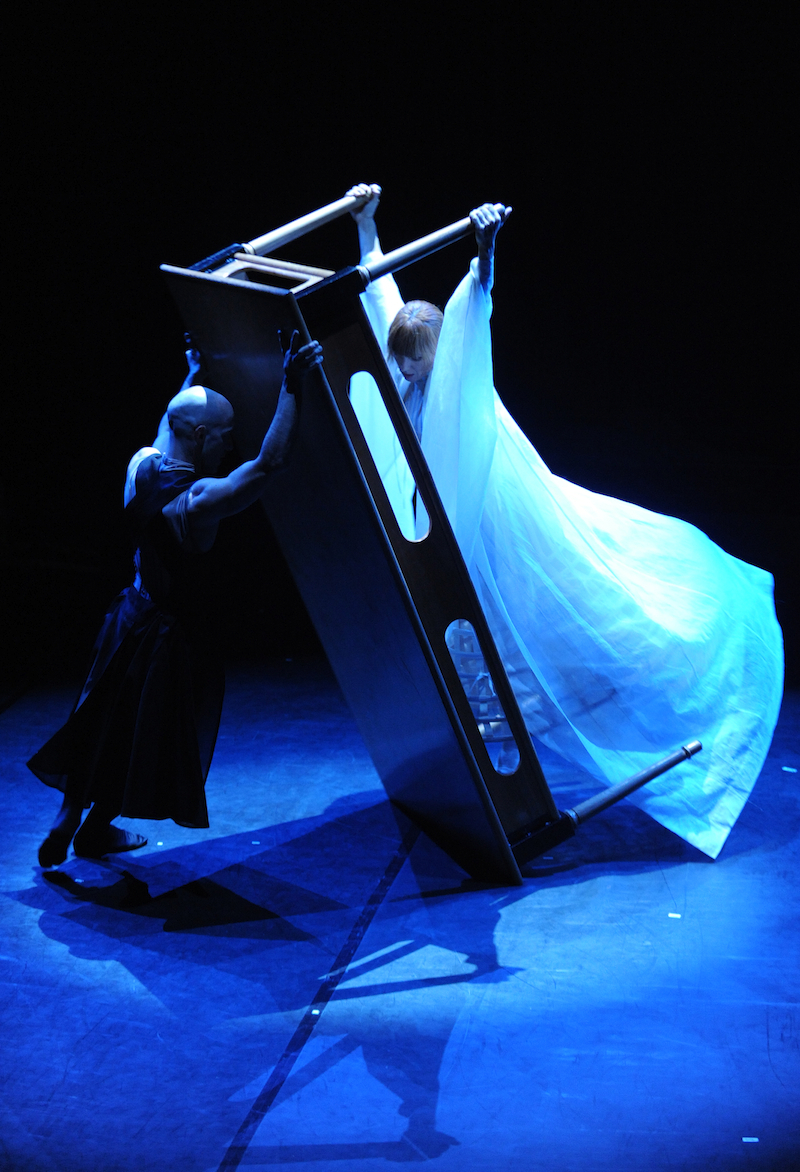 And then came Eonnagata (Guillem and Mailphant pictured by Erick Labbe/SWT), with Robert Lepage as well as Sylvie - and that is quite high up the food chain. Is that the most international thing now for you? Obviously you also now work with Akram Khan, with whom you just did DESH. So in terms of how the food chain works, Broken Fall was make or break.
And then came Eonnagata (Guillem and Mailphant pictured by Erick Labbe/SWT), with Robert Lepage as well as Sylvie - and that is quite high up the food chain. Is that the most international thing now for you? Obviously you also now work with Akram Khan, with whom you just did DESH. So in terms of how the food chain works, Broken Fall was make or break.
Yes, because we felt stuck in this underfunded position where not many opportunities presented themselves, yet we knew that when we did things people did quite like them. We couldn’t keep fighting again and again for a bit more sticky tape for the window, or a little bit of project funding. We won a few awards, an Olivier Award, and it happened at just the right time to rescue our despair.
You’ve worked with Michael and Billy again on one of the pieces in The Talent programme currently touring?
Yes, it’s Torsion, which we’ve redone for six dancers rather than two.
One of the things that’s struck me in the years I’ve been seeing dance, is that there is an incredibly talented layer of seasoned and outstanding creators, Russell, Jonathan, Javier [de Frutos], you, Kim Brandstrup, Michael Clark and so on, who remain struggling with earning a basic living, even in their forties. I don’t understand how that continues to be. In Belgium I assume you’d all be rich…
It’s as well I’ve never been in it for the money. I live in a tiny housing association flat. When i got to that despairing point, I’d been working for so long for so little… things like cars, mortgages, children, were never going to be realities. Scratching around trying to survive.
There is an incredibly talented layer of seasoned and outstanding creators in dance who remain struggling with earning a basic living, even in their 40s
And you’ve been working for nearly 30 years now…
Pretty much. When I started I really didn’t know much about theatre, I was making sets and my friend John was doing the lighting, so I’d hold the ladder as he went up to fix them. I looked at going to college to do theatre design, but in the 1970s there really wasn’t much in college. I applied for theatre design courses, but realised that going to college for three years and only making maybe one production a year, when I’d already been doing three a year, I thought it was dull. But my father spotted in the Guardian a four-year BA Honours in theatre and dance at Dartington, and I said, that’s it! Because you could act and direct and write and move as well. My father told me his sister, my aunt, had been there in the Forties to study painting - and everyone there smoked opium and swam naked in the river. I said, I’m off. I had Steve Paxton there teaching me about dance, two years of contact improvisation, and another slightly strange American, Mary Fulkerson, who was head of the dance department. I was incredibly lucky that Steve [the inventor of the influential modern dance technique, contact improvisation] was teaching there at the time.
Who switched on the light for you, as it were, about lighting?
Laurie Booth, afterwards. [Laurie Booth, the dancer and choreographer] He’d left Dartington a couple of years before me, but he was still coming back and showing his early works. I'd spent most of the 1980s hanging out in derelict buildings making site-specific theatre shows. Felt this was about as good as I could do, so I started working in theatre designs and costumes. But then realised it wasn’t actually satisfying me. I stopped, I didn’t know what to do. As I would bump sporadically into Laurie, he understood I was design-based and asked me to come and do some lights for him. I hadn’t thought of it, but I said yes. I’d had no lighting training.
You know we critics have this joke about most contemporary dance being just three lightbulbs.
Cheeky lot. But sometimes it’s all we can afford. I started in lighting entirely by improvising with Laurie, because I’d had no training. If I’d had training, I couldn’t have done it.
Having been a dancer, did that make you more conscious of how imperfections can be changed, or shadows make impacts and so on?
Yes, and a lot more, because I understood something about the theatre of light. And it also gave me the opportunity to revisit the murkiness that I’d been so excited by in that Mermaid Treasure Island. The project with Laurie turned out to be Spatial Decay. After its initial appearance as a quartet, Gill Clarke and Scott Clark went back to Siobhan Davies, and that just left Laurie and Russell. Which was how I met Russell - a fantastic duet, and I’m improvising the lighting. And in 1992 Russell and I are hanging around hotels, and we decide we should use improvisation as a tool to create dance and light material, but then to make structured performances from that, not improvised performances.
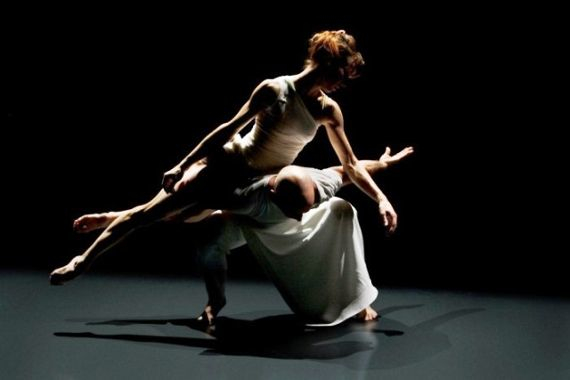 It’s complete give and take, is it? You’re moulding the work together?
It’s complete give and take, is it? You’re moulding the work together?
Yes, one of the things that Russell is interested in is how I’m manipulating the space, the sculptural quality of it. And I noticed how Russell would dance differently on the edge of light from how he’d dance in the middle of it. He had a sensitivity to it. (Maliphant and Guillem in Push, pictured by Johan Persson)
My impression has been that most dancers dance to a mirror, in a sense, due to their training, so is it very rare, what Russell does, that he doesn’t dance into a mirror, but dances into the space?
Yes. You get people like Jonathan and Russell who get to a point in the world of ballet where they think, what am I doing? Russell took a while to get away from it, he did a lot of other things, like capoeira, or with Michael Clark and Lloyd Newson, or martial arts. Russell’s movement comes from an internal place in his body, it’s not coming in from an outside form. I'm the same in that I'm intuitive, I wasn't taught lighting design. My only experience of being taught was in 1992 when I went to New York to do a two-week workshop with Jennifer Tipton and Dana Reitz. I’m not sure they were using light as a catalyst to create dance. And because Dana doesn’t use music, it’s all rather silent and austere. But it was a living proof to me of what I’d been talking with Russell about, that we could do a collaboration of light and dance. These two women were already doing it.
What did you learn from Tipton? Is she an imaginative person you responded to?
Why did I go there? I’d only just started as a lighting designer. I’d been told she was brilliant, the best in the world. I wanted to be inspired. And it was inspiring seeing that the kind of thing that Russell and I were trying to do wasn’t so crazy. I learned what phenomenal eyesight Jennifer Tipton has. If I were Frankenstein and were building my creature, I’d want her eyes in that creature, because she can spot a flaw in a light from 500 yards. I realised how insensitive my eyes were in comparison.
It’s like the chef training the palate. Can you train your eyes to be receptive to shades, gradations, edges?
Yes, I think you do. Observing things is a skill that doesn’t particularly seem to be taught.
It’s like dissociating your brain from your vision: you are both watching through the front of your eyes and also observing in all-round vision where you are - that's the experience for me as the theatre-goer.
Yes, you want all your senses highly attuned, eyesight particularly for me. I guess, I’d find it quite easy to dissociate the logical part of the brain because I’m interested in the imagination much more. (Below, Sylvie Guillem dances Maliphant's solo Two, lit by Michael Hulls.)
Are there sights that inspire you?
Yeah, all the time, mostly in the natural world. Or in the colour of shadows. People think shadows are blackness, but they're not. Overhead in my bedroom there’s a blue bulb in a pendant holder over the bed, and just between the bayonet cap and the main bulb there’s a little bit where the blue paint didn’t go. So a tiny bit of white light comes from a tiny little crack, and creates a sort of swirling cloud, with the black hole in the middle that’s the shadow of the pendant fitting.
I’d been looking at this for years, thinking, how can I do that for the stage? And then AfterLight came along. We were using projections, and I was explaining to the animator it should be like a picture of a cyclone on a weather map, a swirling feathery-edged cloud with a black hole in the middle. He went away, came back, got it. Then I got it to rotate and got the dancer to start rotating at the same speed as the rotating cloud. You could never see the dancer’s feet, so it looked like he was on a turntable - brilliant. And that was the start of AfterLight. That’s what I mean about light being a catalyst for choreography. (Below, Daniel Proietto in AfterLight, pictured by Charlotte MacMillan)
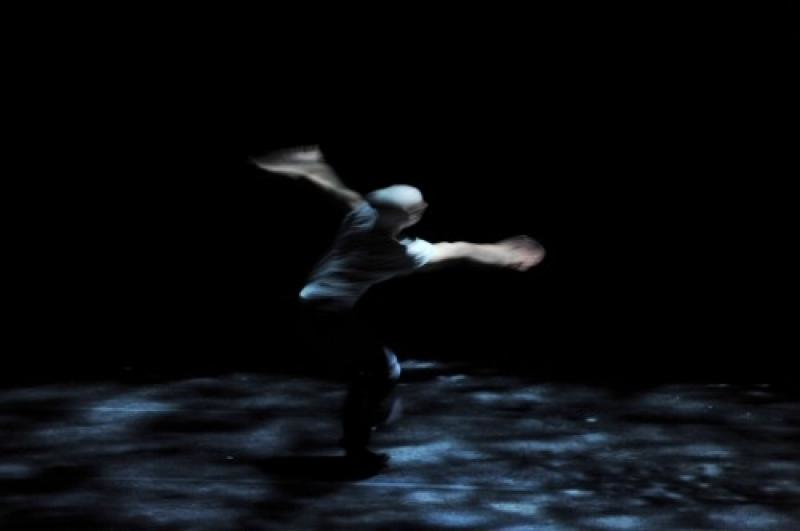
What’s your lighting like at home?
No overhead lighting, little spots, at low level. Candles at night, always. I have a specific light to read under. It’s all very localised lighting. Luckily, little mini tungsten spot bulbs are still legal. I have so many of these new low-energy bulbs, a total nightmare. Every time a new one comes out I try it, hopefully, but the quality of light is just nasty. Tungsten, candlelight - fantastic.
Has any of that low-energy, longlife regulation hit stage lighting yet? Are you still allowed normal lights?
You are still allowed to use normal lights but there’s a whole new generation of lights emerging that are low-energy LED now. I’m using some of them for the first time here. Those two big blobs on my plan are VLXs and these five are a much smaller kind of LED. The new lights are efficient in generating colour, because you can mix, rather than having to scroll gels. You’ve been able to change colour by mechanical means for a long time by having scrolls of different coloured gels, there’s no person up a ladder now. But now LEDs are getting much better; you need those with red/blue/green plus cold white and warm white to be able to get good colour tones, and particularly tints, which are always the challenge. These LED devices are controlled from the lighting desk. The thing that’s really important is light that moves, rather than having a series of lights along a line. Like the traffic effect in DESH.
If you’re saying your lighting is intuitive, you’re in a sense painting with light, I imagine that to find a symbiosis with a dancer who is becoming, as it were, a brush for the light on stage is almost impossible - I mean, how Sylvie has managed to shed the mirror-image ballerina and become someone who dances from within herself is her own journey. But I noticed that many modern choreographers, eg Twyla Tharp, are making their dancers move forward, as it were, they're about momentum, not sculpture. People like Merce Cunningham’s dancers or a very few great Russian ballet dancers dance in 3D, so that any angle of them is as fascinating as any other. There’s a feeling of space on them in the round, light on their skin, they’ve got to sense it.
Yes, you can feel it, you can feel its warmth, or you can find its shadow and locate yourself.
Is that what you ask a dancer to do? To orientate by a shadow?
Yes, it’s the simplest way to explain to a dancer. Keep your shadow visible here or you’ve lost the light.
You’ve worked with a lot of choreographers - you’ve worked with Baryshnikov...
That was a piece by Meg Stuart. She always had long titles - something like Swallow My Yellow Smile…
...Jonathan, Russell, Akram.
Yes, I’ve worked with Akram over 10 years now.
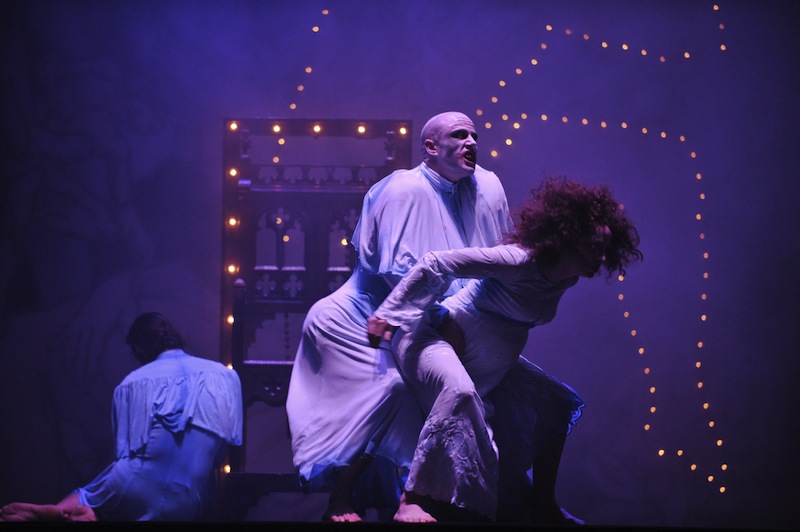 And the more theatrical work of Javier - you did his notorious screaming pope, Eternal Damnation for Sancho and Sanchez at Sadler's Wells (photograph Hugo Glendinning/SWT), and Cattle Call for Phoenix Dance…
And the more theatrical work of Javier - you did his notorious screaming pope, Eternal Damnation for Sancho and Sanchez at Sadler's Wells (photograph Hugo Glendinning/SWT), and Cattle Call for Phoenix Dance…
To me that is working on the level of fun. I really like Javier as a character. I’m interested in working with people of my generation, not really going outside of that. In the last 15 years, the only people I have worked with are Russell, Akram, Javier, Jonathan. There are very few people I’m interested in working with. My work with Russell has been a long-term exploration, adventure. Akram, and Jonathan for a while, before he became more hermit-like, and Javier, for a bit of fun. He’s been in Israel a lot recently, doing Cabaret in Tel Aviv. He’s started talking about something with me, about making a solo on himself - going back to his roots. Which will be a change from his big sensational spectaculars. I did work with Shobana on a piece with Richard Alston, Romance with Footnotes, but with Javier it’s just about having fun.
When he did Cattle Call, written by Richard Thomas, that was just so knowing, camp, theatrical OTT, I was quite surprised it was you doing it! And as for Eternal Damnation… I’m quite sorry it’s unlikely to be revived.
Extremely unlikely! Yes, I’ve had a lot of fun with him. It’s totally different territory
DESH was breathtaking. It looked highly complex. Did Akram come to you with a storyboard?
No, we made it up as we went along, together.
What was that jet engine/tumble dryer thing?
He found it in Grenoble! He was rehearsing there, and found this. It belongs to the Comédie Française, and he fell in love with it. It’s actually an incredibly powerful fan. He started to refer to it as his girlfriend, and everyone else involved in the production thought, why? What is it? Let him be… It’s his new girlfriend. And gradually people became convinced that actually it was important, and relevant, and part of the piece. It became apparent to several of us that it had to be what was going to create the monsoon, it was going to be the force of nature. Against lots of people’s judgment originally, it became an integral part.
We all made it up as we went along. We went to Bangladesh in November 2010, Akram, Jocelyn [Pook, composer], myself, Tim [Yip, designer], Farooq [Chaudry, Akram's manager]. Various others. We spent time in Bangladesh, absorbing things, getting ideas. Jocelyn would record bits of sound that would get used in the score, I’d be just looking and recording sights in the hard disk in my head. Then we went to Beijing for a design meeting in Tim’s office, and there and thern within about 36 hours, we decided what the set should be. We wanted the sludgy green concrete on the wall of the studio that was the world we wanted to be in. Never mind what Tim ws showing us in the models. A lot of design is about recognising things, it’s not always the obvious. And of course the whole sky-forest thing was a development - or a steal - from Tim's work on The Banquet, the most expensive Chinese film ever made. There was a scene he showed us from the film where the ceiling is the tips of lots and lots of pieces of fabric, and Akram and I said, we want that, and we want it down to the ground. That established that there wouldn’t be much space for lighting, with this enormous sky forest above the stage. It would be in three sections so I could have just four rows of lights, and that determined a lot about limitations. And limitations are good in lots of ways. (Below, Akram Khan in DESH's video trailer)
It was great to work with Akram again - In-I hadn't been a particuarly happy experience. I'd met him via Jonathan. Jonathan had choreographed some dance for Kevin Volans’s 50th birthday concert at the South bank, where Jonathan danced a duet with Akram, and I was knocked out by the way Akram moved. And then Dance Umbrella commissioned a solo from him in around 2001 and Akram asked me via them if I would do it. I said yes, of course, what a phenomenal mover. Then he made a show called Fix, and worked on a trio called Rush, in which he was dancing as well as choreographing. And it became apparent to me that during it, he wasn’t ready to do that. It was quite a big leap in the tools you need in the box to move from choreographing on yourself to choreographing on yourself and other people, to be both inside and outside the piece. And also I felt there was an imperative for world domination going on. Farooq’s attitude of we’ve got to go out and conquer the world now. I’m saying, no, he needed to take it slower and develop, so I started saying no to doing things with him. Also I was so busy working with Russell.
You didn’t do Kaash. I suspect that was a challenge to light an Anish Kapoor.
That was the first one I turned down. I’d worked with Anish before, actually with Laurie Booth. Didn’t have any problem working with Anish... Then he asked me to do In-I, and it wasn’t a happy experience. It didn’t give Akram... I sound condescending or something, but I wanted to see he had developed from where I’d stopped with him, and he didn’t get that opportunity in In-I, because he wasn’t sole director of it. It was two-headed with [actress] Juliette Binoche, and not 50-50 at all. So again I said no to him after that. But I said, I want to do a solo with you.
And then we started doing DESH and I could see how far he’d now come. It was one of the best experiences I’ve had, best resourced, best in time, rich in content, right group of people. It was one of those rare, well, not that rare, if you’re careful who you work with… it developed in a beautiful, fluid, sympathetic way. No clash of egos, no clash of aesthetics. Halfway through making it, I said to Akram, usually when you’re making something, especially on this kind of scale, involving video, music, light, text, props, dramaturgy, there’s a point when you cut everything up you’ve made, throw it all up into the air and see how it falls and fits. But this isn’t going to happen here, because this feels as if in a very organic way it’s creating itself, without all that angst. And now I do want to work with him again, because I can see how far he’s developed.
I presume the injury is very frustrating.
It was already all settled at Sadler's Wells for October, as I understand, it had two slots, so it’s just lost the spring one… It’s the Achilles that he’s ripped and broken. I think the rest will do him good. They say performance is suspended till May. He did the injury at the beginning of December. But then he’s also got stuff to do for the Olympics.
Russell's new Rodin Project with you on 5 February at Sadler's Wells - is that complete or are we seeing a sample?
You’re seeing all of it. It’s a nightmare, because next week we’re in there (Sadler's Wells Lilian Baylis Studio) working on it, the following week we have a production week in the Théâtre Chaillot, in Paris, who are co-producers, then we open in Paris, have four performances, rush back here on Saturday for one performance on Sunday here, and then rush back to Paris again to perform again.
With this one we’re working with a set for the first time ever. It came from the idea of plinths and sculpted figures on plinths. So it’s a wonky pile of variously angled plinths rammed together. It’s in two acts, and in Act 1 the whole thing is soft, draped in white fabric, we’re in a world of soft shapes. Act 2 is all hard, black, angular. So we’re working with a set for the first time - Es Devlin. It was inspired by the work of Rodin, though it's not about the work of Rodin. In the way that AfterLight was inspired by Nijinsky and the Ballets Russes. That was the first time we’d taken an external source as inspiration. We really enjoyed that process of having fantastic, big work by other people to be inspired by. (Below, The Rodin Project in rehearsal, photograph by Charlotte MacMillan)
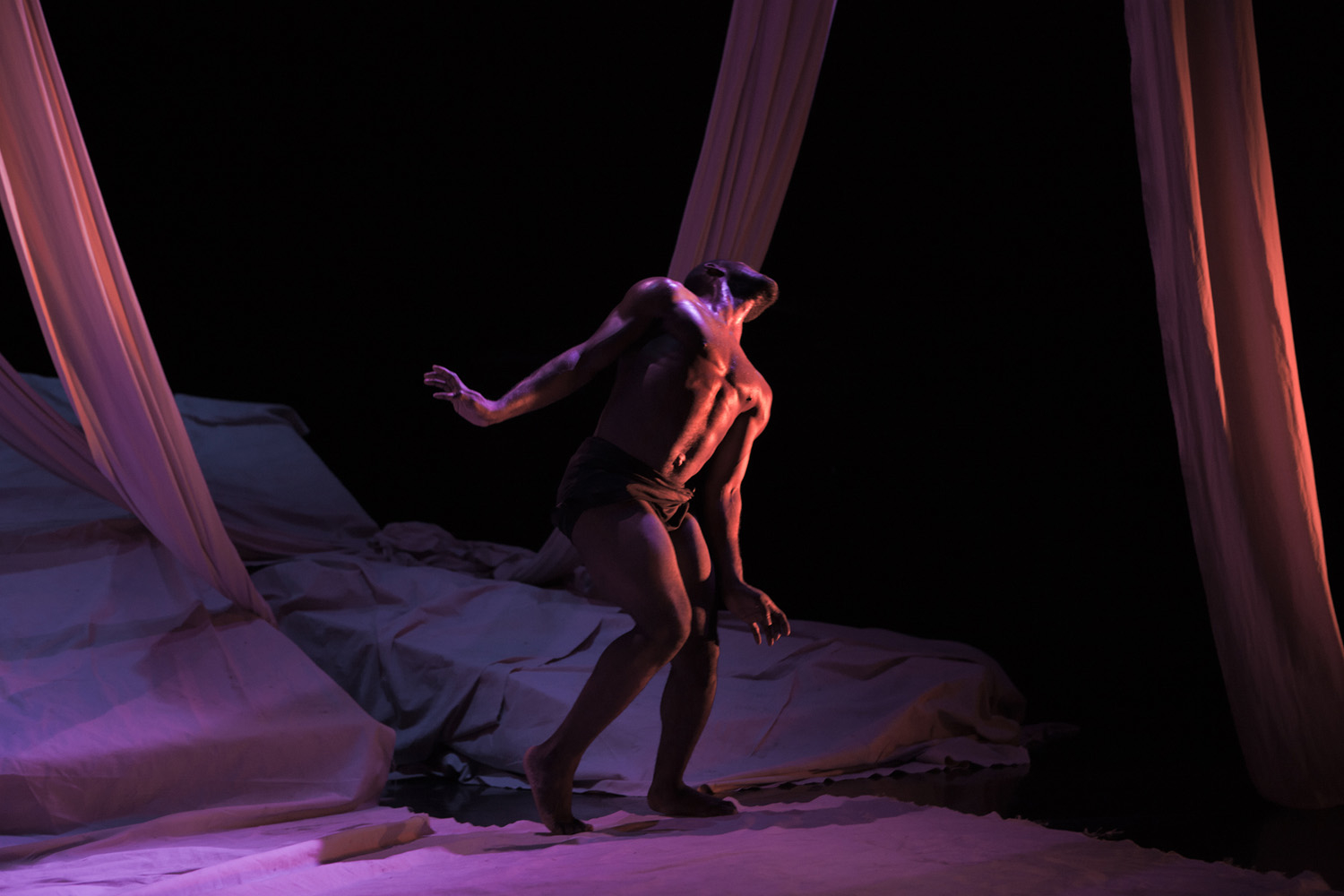
Do you gradually feel more confidence in your success? Are you still staving off despair?
No. No. Given that I said I haven’t been interested in money, it’s nice to have some in the bank for the first time ever. And to win a big sword [as a Knight of Illumination in 2009], and be nominated for an Olivier Award. And to get into the Oxford Dictionary of Dance. The pen is mightier than the sword, but the sword is good fun.
But at the same time I’ve had a level of professional recognition, I’ve had personal tragedy. My wife died in 2007, after three years battling cancer, at the same time this was all going on. I’m just getting over that. It’s been a pretty dark place for me, the last seven and a half years. But personally I’ve realised that things have moved on. Thankfully. Push was made when I wasn’t in hospital or at home nursing Michèle. We were together for 16 years, we only got married 11 months before she died, because we needed some goal to stay alive for. A brilliant four-day extravaganza of a wedding party. That’s been hard. I spent all the time I possibly could at hospital with her, and thankfully my royalties made that possible. So it was a really good use of earning more than I’d done previously.
I remember Merce Cunningham saying in his eighties that he’d struggled all his life just to keep his company going, despite all the fame and celebrity.
I ask just to look after myself, afford a bottle of Pino Grigio and eat seafood once in a while. Apart from that money doesn’t buy what really matters. But the struggle is about getting the resources and money to make work. And that is an unrelenting struggle.
- This is an update of the article originally published here on 21 January 2012
- Michael Hulls lights Russell Maliphant's company production Still Current, performing 14 May 2014 at Richmond Theatre, London; 23-24 May at the MAC, Belfast; 27 May at The Lime Tree Theatre, Limerick; 28 May, Cork Opera House, Cork - booking details
- The Ballet Boyz perform their Serpent/Fallen double bill (lit by Hulls) with a new creation at the Roundhouse, London, 31 July-1 August, 2014
Share this article
The future of Arts Journalism
You can stop theartsdesk.com closing!
We urgently need financing to survive. Our fundraising drive has thus far raised £49,000 but we need to reach £100,000 or we will be forced to close. Please contribute here: https://gofund.me/c3f6033d
And if you can forward this information to anyone who might assist, we’d be grateful.

Subscribe to theartsdesk.com
Thank you for continuing to read our work on theartsdesk.com. For unlimited access to every article in its entirety, including our archive of more than 15,000 pieces, we're asking for £5 per month or £40 per year. We feel it's a very good deal, and hope you do too.
To take a subscription now simply click here.
And if you're looking for that extra gift for a friend or family member, why not treat them to a theartsdesk.com gift subscription?
more Dance
 'We are bowled over!' Thank you for your messages of love and support
Much-appreciated words of commendation from readers and the cultural community
'We are bowled over!' Thank you for your messages of love and support
Much-appreciated words of commendation from readers and the cultural community
 Peaky Blinders: The Redemption of Thomas Shelby, Rambert, Sadler's Wells review - exciting dancing, if you can see it
Six TV series reduced to 100 minutes' dance time doesn't quite compute
Peaky Blinders: The Redemption of Thomas Shelby, Rambert, Sadler's Wells review - exciting dancing, if you can see it
Six TV series reduced to 100 minutes' dance time doesn't quite compute
 Giselle, National Ballet of Japan review - return of a classic, refreshed and impeccably danced
First visit by Miyako Yoshida's company leaves you wanting more
Giselle, National Ballet of Japan review - return of a classic, refreshed and impeccably danced
First visit by Miyako Yoshida's company leaves you wanting more
 Quadrophenia, Sadler's Wells review - missed opportunity to give new stage life to a Who classic
The brilliant cast need a tighter score and a stronger narrative
Quadrophenia, Sadler's Wells review - missed opportunity to give new stage life to a Who classic
The brilliant cast need a tighter score and a stronger narrative
 The Midnight Bell, Sadler's Wells review - a first reprise for one of Matthew Bourne's most compelling shows to date
The after-hours lives of the sad and lonely are drawn with compassion, originality and skill
The Midnight Bell, Sadler's Wells review - a first reprise for one of Matthew Bourne's most compelling shows to date
The after-hours lives of the sad and lonely are drawn with compassion, originality and skill
 Ballet to Broadway: Wheeldon Works, Royal Ballet review - the impressive range and reach of Christopher Wheeldon's craft
The title says it: as dancemaker, as creative magnet, the man clearly works his socks off
Ballet to Broadway: Wheeldon Works, Royal Ballet review - the impressive range and reach of Christopher Wheeldon's craft
The title says it: as dancemaker, as creative magnet, the man clearly works his socks off
 The Forsythe Programme, English National Ballet review - brains, beauty and bravura
Once again the veteran choreographer and maverick William Forsythe raises ENB's game
The Forsythe Programme, English National Ballet review - brains, beauty and bravura
Once again the veteran choreographer and maverick William Forsythe raises ENB's game
 Sad Book, Hackney Empire review - What we feel, what we show, and the many ways we deal with sadness
A book about navigating grief feeds into unusual and compelling dance theatre
Sad Book, Hackney Empire review - What we feel, what we show, and the many ways we deal with sadness
A book about navigating grief feeds into unusual and compelling dance theatre
 Balanchine: Three Signature Works, Royal Ballet review - exuberant, joyful, exhilarating
A triumphant triple bill
Balanchine: Three Signature Works, Royal Ballet review - exuberant, joyful, exhilarating
A triumphant triple bill
 Romeo and Juliet, Royal Ballet review - Shakespeare without the words, with music to die for
Kenneth MacMillan's first and best-loved masterpiece turns 60
Romeo and Juliet, Royal Ballet review - Shakespeare without the words, with music to die for
Kenneth MacMillan's first and best-loved masterpiece turns 60
 Help to give theartsdesk a future!
Support our GoFundMe appeal
Help to give theartsdesk a future!
Support our GoFundMe appeal

Add comment